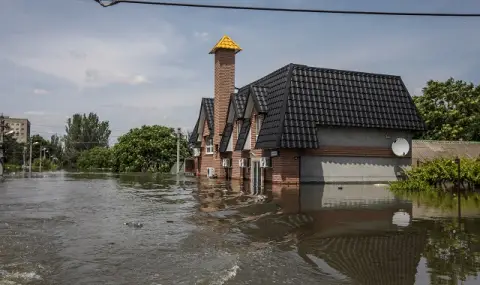The destructive flood that devastated a number of Russian regions is receding. But rivers and drinking water may have dissolved uranium from abandoned deposits. According to ecologists, 100 to 300 uranium wells remain underwater.
Unprecedented flooding, which has caused destruction in various regions of the southern Urals in Russia, may have affected a number of dangerous sites, environmentalists say. They point in particular to the flooded old uranium deposits in Kurgan Oblast and a slag dump in Novotroitsk, Orenburg Oblast. Hazardous substances can cause an epidemic of cancer and other diseases among the local population. Russian authorities and state agencies deny the consequences of the catastrophic floods, accusing environmentalists of disinformation.
Several hazardous chemical facilities are in the flood zone
As early as 2022, researchers from Orenburg University have looked at various scenarios of severe disasters and catastrophes in their region, including from a severe flood. Their concerns were related to the fact that 27 hazardous chemical facilities were operating in the Orenburg region: in many of them, the equipment was already heavily depreciated. In their report, the scientists pay particular attention to the possibility of destroying toxic waste tanks. In a pessimistic scenario, the contamination zone in the event of a release of dangerous chemical substances could spread over an area of up to 1,500 square kilometers, they predict.
The ecological project "Earth is important for everyone" drew attention to the fact that the current destructive flood has flooded the Novotroitsk slag dump. A local metallurgical enterprise stores production waste there with a high concentration of heavy metals. Environmentalists fear that harmful substances may have already entered the water and are dangerous for local nature and living creatures.
The flood has reached uranium wells in the Kurgan region
The situation in the Zverinogolov region of the Kurgan region, where part of the old uranium wells, which may contain radioactive substances, remained under water in April, environmentalists told DV. Their words were confirmed by satellite photos, video recordings and accounts of witnesses from the region.
At this place, in Soviet times, experimental work was carried out in the "Dobrovolnoe" uranium deposit, which, however, was stopped and recognized as dangerous even then - precisely because of the danger of floods, says Navalny's former chief of staff in the Kurgan region , the physicist and ecologist Alexey Shvarts. In the mid-1980s, trial mining of uranium was carried out in these mines, adds nuclear physicist Andrey Ozharovsky, an expert from the Russian Social-Ecological Union.
Radioactive particles can get into drinking water
Based on the available information, ecologists are convinced that the dissolved uranium got into the Tobol River. According to Ozharovski's calculations, there is a high probability that people living downstream of the river will be exposed to the so-called "collective dose" radioactivity - low for an individual, but dangerous due to the effect on a significant number of people. Along the Tobol river is the city of Kurgan with a population of about 300,000 people, and besides it there are a number of other settlements.
The river is the main source of drinking water for hundreds of thousands of people, and the treatment facilities are not able to filter out radioactive particles, says Ozharovski: "If a person takes radioactive substances with water or food, it can be the last straw. which will overflow the glass and cause an oncological disease”. The specialist advises local residents to drink only bottled water.
According to environmentalists, the water may have flooded 100 to 300 such uranium wells. Some of these wells are still leaking residual uranium solution, says Ozharovski, who has personally observed the dangerous phenomenon. He participated in a well survey in 2019. Seven of the 12 wells tested at the time were still radioactive. According to him, it is difficult to estimate how much radioactive liquid from them may have entered the water during the current flood.
"Rosatom never testifies against itself”
Alexei Schwartz explains that measuring the degree of contamination of water with radioactive particles requires complex studies: "The water must be evaporated, the sediment must be passed through a spectrograph, etc. Only a Rosatom laboratory can do this." However, Schwartz doubts that the state concern will carry out such measurements or make the results public: "Rosatom never testifies against itself”, he says.
Rosatom does not share the concerns of environmentalists at all: On April 23, “Dalur” - the company that manages the "Dobrovolnoe" deposit called the reports of a possible spill of radioactive liquid "deliberate disinformation". The company explains that the deposits are located on high ground and are not affected by the flood.
This information is partly confirmed by Andrey Ozharovski, who specifies that the subsidiary of Rosatom "Dalur" drilled new boreholes on the uplands a few years ago, but the wells not mentioned in the official report are in the lowlands. It was they who flooded, says Ozharovski.
Like after the Chernobyl accident?
Environmentalists loyal to the Russian authorities claim that the flood did not affect any dangerous sites. “There are still no irreversible consequences”, he said in an interview with the "Parliamentary Gazette" Viktor Danilov-Danilyan, scientific director of the Institute of Water Research of the Russian Academy of Sciences. According to Maxim Tokarev, a member of the expert council of the Committee on Ecology and Environmental Protection of the State Duma, the main threat came rather from flooded cemeteries, outdoor toilets and other sanitary facilities. He admits that pesticides and herbicides can pollute large areas, but claims that "cleanup measures" can remove the severe consequences.
For his part, Alexey Shvarts says that the silence of most of the environmental community and the attempts of the Russian authorities to "silence" the problem is reminiscent of the situation with the accident at the Chernobyl nuclear power plant. The USSR authorities then failed to hide the consequences of this catastrophe. Ecologist Schwartz believes that from year to year the floods in the Southern Urals will become more and more destructive, as well as their consequences.
